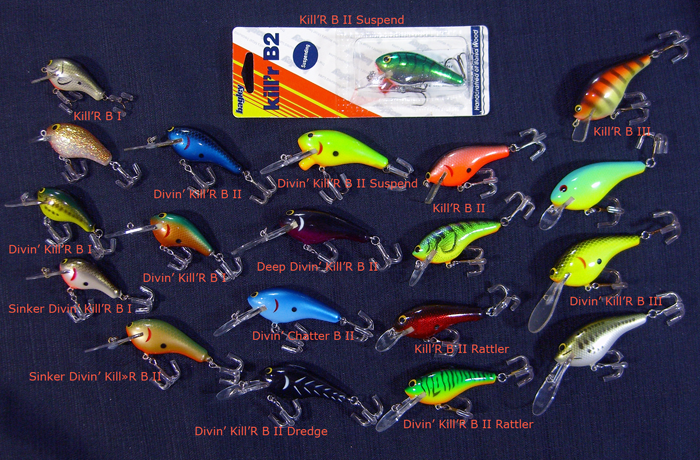Bagley Kill'R B Series
The all-purpose Kill'R B line of baits, also know as Killer B's, was Bagley's version of the Swiss Army Knife. They were versatile enough to be fished from 0'-12', in open water or heavy cover, and in water tempature extremes that ranged between 33° and 86°. No self respecting tournament bass fisherman in the South would be caught dead without at least a couple of the Kill'R B's in their tacklebox. I doubt there has ever been a better crankbait for throwing into shallow treetops on the man-made impoundments and river systems across our nation. The large plastic lip of the Divin' Kill"R B's protected the body and hooks from snagging in heavy cover. With the extreme bouyancy of the balsa body, even if it momentarily got caught in the fork of a tree branch, using a slight popping motion with your rod tip, the lure would back itself out and float to safety...that is, if a monster bass
hadn't grabbed it as it backed away from the cover, which happened frequently enough that you anxiously gripped your rod for a couple of seconds as the lure came free.
Click image to view a larger picture. Click again if plus sign (+) is present.

Up until 1980, the Divin' Kill'R B's were made with a thin plastic bill featuring a lead weight that helped the bait get deeper, faster. The shallow running Kill'R B's also had a thin plastic square bill on the older models. Because of breakage, they changed to a reinforced lip without lead on both the shallow and deep running baits. This all changed back when the company started production in the Dominican Republic. The Diving B's again had lead in the lip, but now the lip was reinforced. As of 2012, this is still how they are manufactured. The newer Kill'R B's have their model name printed on the belly of the bait, while the older models don't.
In 1978 the "Sink-N-Swim" was added to the Kill'R B I, Kill'R B II, and Divin' Bang-O-B lines. These lures were weighted to cause them to sink at a rate of one foot per second. There is an uppercase "S" stamped on the bills of these baits.
In 1987 a "specially calculated" weight was added to the Kill'R B II's to make them sink more quickly. This model was called a "Dredge". Around this time the Chatter B II's and III's were introduced. They were made in the shallow and deep diving Kill'R B bodies.
The relative lengths of the bodies (not including the diving bill and rear screw) of each Kill'R B is as follows: 1 3/4" to 1 7/8" on the KB1, 2 3/8" to 2 1/2" on the KB2, and 2 3/4" to 2 7/8" on the KB3. Typically, the older, all brass hardware lures were slightly smaller than the newer versions. This seems especially true of the KB1's, which are often confused with Bagley's Bitty B's.
Click image to view a larger picture. Click again if plus sign (+) is present.


This picture shows the different diving bibs you can expect to find on Kill'R B 3's. From left to right: KB3 squarebill, KB3 reinforced round bib, DKB3 with reinforced diving bib, DKB3 with lead in lip, prototype DDKB3 with DB06 bib, and a DB06 for comparison with the proto.
Click image to view a larger picture. Click again if plus sign (+) is present.

B Flat (They naturally triggered the attack instinct in large bass.)
Balsa B (Bagley's hughly popular entry into the "Alphabet" lure phenomenon.)
Bang-O-B (Versatile hybrid of the Diving B and Bang-O-Lure.)
Bang-O-Lure (Jim Bagley's favorites.)
Honey/Bitty B (Bassmaster Classic Winner!)
Divin' B (The Diving B's were among the most popular Bagley models.)
Kill'R B (The Kill'R B's were the all-purpose Bagley's.)
Bagley Shiner/Pinfish (Deadly in clear water!)
Small Fry Shad (The Small Fry Shad fished as good as it looked!)






